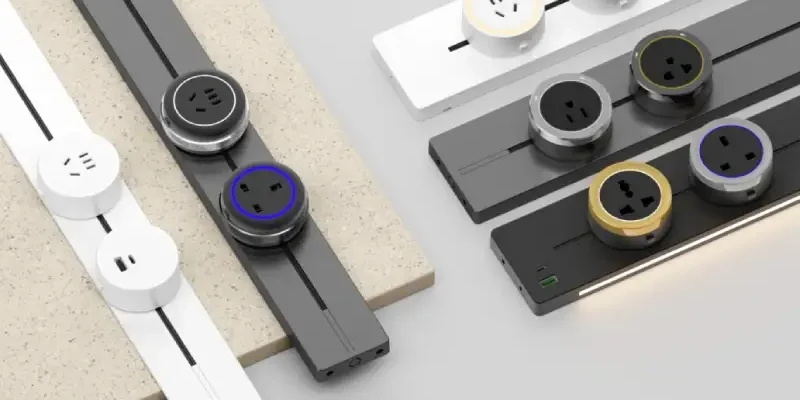Коли справа доходить до розподілу електроенергії в будинках і офісах, вибір зазвичай зводиться до традиційних подовжувачів або більш сучасних розеток. Обидва варіанти мають на меті забезпечити додаткові розетки, проте вони суттєво відрізняються за дизайном, функціональністю та сферою застосування. Давайте розглянемо ці відмінності, щоб допомогти вам вирішити, який з них найкраще відповідає вашим потребам.
Гнучкість і мобільність
Розетки для силових доріжок:
Розетки для силових треків легко адаптуються. Вони дозволяють переміщати розетки вздовж змонтованої шини, що робить їх ідеальними для таких приміщень, як конференц-зали або кухні, де вам часто доводиться переставляти пристрої. Така гнучкість означає, що ви можете розмістити розетки саме там, де вони вам потрібні в будь-який момент.
Традиційні розетки:
На відміну від них, традиційні подовжувачі мають фіксоване положення. Після того, як ви ввімкнули їх у мережу, ви не зможете пересувати розетки, хіба що фізично перемістите весь подовжувач, що робить їх менш пристосованими до динамічного простору.
Процес встановлення
Розетки для силових доріжок:
Встановлення розеток на шинопроводі передбачає їх кріплення на стінах, стелі або підлозі. Це може бути простий процес, але він є більш довготривалим, ніж просте підключення подовжувача. Така установка дозволяє отримати акуратне та організоване рішення для електропостачання, пристосоване до ваших конкретних потреб у плануванні.
Традиційні розетки:
Традиційні подовжувачі виграють у цьому питанні. Вони не потребують ніякої установки, окрім підключення до існуючої розетки. Цей аспект plug-and-play робить їх швидким і простим рішенням для тимчасових налаштувань або негайних потреб в електроживленні.
Особливості безпеки
Розетки для силових доріжок:
Системи силових треків оснащені передовими функціями безпеки, такими як захист від перевантаження та короткого замикання. Ці вбудовані механізми підвищують безпеку, забезпечуючи спокій при підключенні декількох пристроїв, мінімізуючи ризики ураження електричним струмом.
Традиційні розетки:
Хоча деякі традиційні подовжувачі можуть мати базові функції безпеки, такі як запобіжники або автоматичні вимикачі, їм, як правило, не вистачає розширеного захисту, який можна знайти в системах силових доріжок. Це може призвести до необхідності встановлення додаткових захисних пристроїв для забезпечення безпеки.
Вартісні міркування
Розетки для силових доріжок:
Розширені функції та гнучкість розеток на шинопроводі мають вищу ціну. Вони, як правило, дорожчі порівняно з традиційними подовжувачами, що слід враховувати при плануванні довгострокових і масштабних електричних установок.
Традиційні розетки:
Традиційні подовжувачі та подовжувачі, як правило, більш доступні за ціною і широко розповсюджені. Вони пропонують бюджетне рішення, особливо підходять для простих, статичних потреб в електроживленні, не вимагаючи додаткового налаштування або встановлення.
Естетична інтеграція
Розетки для силових доріжок:
Однією з важливих переваг розеток на шинопроводі є їхня здатність бездоганно вписуватися в сучасні інтер'єри. Вони мають чистий та інтегрований вигляд, покращуючи загальну естетику вашого простору, забезпечуючи при цьому функціональний доступ до електроживлення.
Традиційні розетки:
Традиційні подовжувачі часто мають більш громіздкий вигляд і можуть не так органічно вписуватися в інтер'єр. Вони можуть виділятися або захаращувати простір, особливо в місцях, де візуальна привабливість є важливою.
Найкращі випадки використання
Розетки для силових доріжок:
Ідеально підходять для динамічних середовищ, таких як офіси, майстерні або кухні, де часто переставляють прилади. Гнучкість, функції безпеки та естетична інтеграція роблять їх придатними для сучасних та універсальних установок.
Традиційні розетки:
Найкраще підходять для тимчасових установок або місць, де потрібні додаткові розетки без постійного встановлення. Вони ідеально підходять для швидкого вирішення проблем, тимчасових проектів або в місцях, де потреба в електроживленні є статичною і простою.
Висновок
Підсумовуючи, можна сказати, що, хоча і розетки, і традиційні подовжувачі слугують основній меті забезпечення розеток електрикою, вони відповідають різним потребам і умовам.
Розетки силових доріжок забезпечують чудову гнучкість, розширені функції безпеки та естетичну привабливість, що робить їх ідеальними для динамічних установок, де вимоги до електропостачання часто змінюються.
Традиційні подовжувачі залишаються економічно ефективним і практичним рішенням для статичних установок, де мобільність не є проблемою.
Розуміючи ці відмінності, ви можете прийняти обґрунтоване рішення, яке найкраще відповідає вашим конкретним потребам у розподілі електроенергії. Незалежно від того, чи надаєте ви перевагу гнучкості та безпеці, чи віддаєте перевагу економічності та простоті, для кожного сценарію знайдеться ідеальне рішення.
Вивчіть свої можливості
Розгляньте свої конкретні потреби та вивчіть наш асортимент розеток для силових доріжок та традиційні подовжувачі, щоб знайти ідеальний варіант для вашого будинку або офісу. Удоскональте свою систему розподілу електроенергії, зробивши правильний вибір вже сьогодні.


